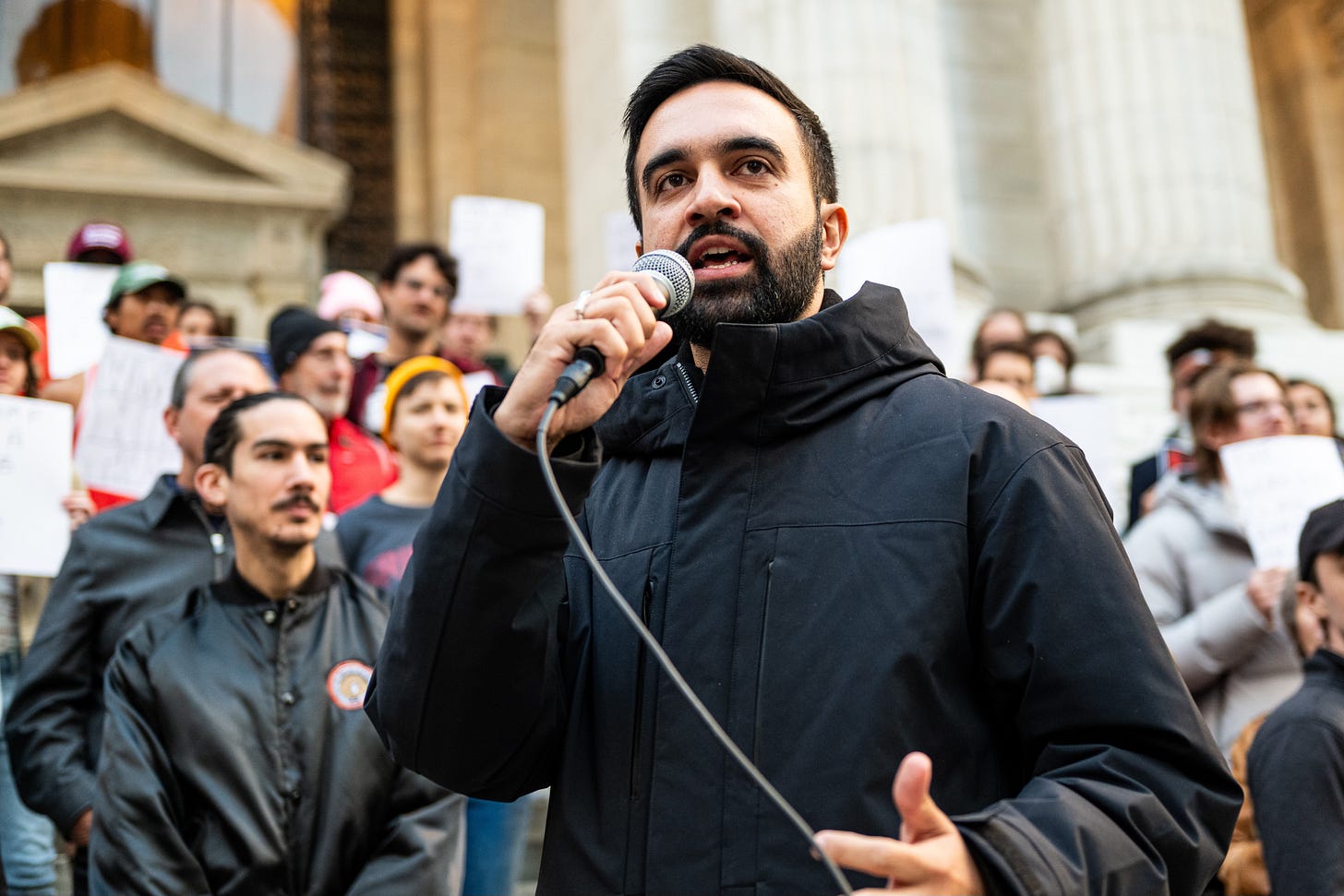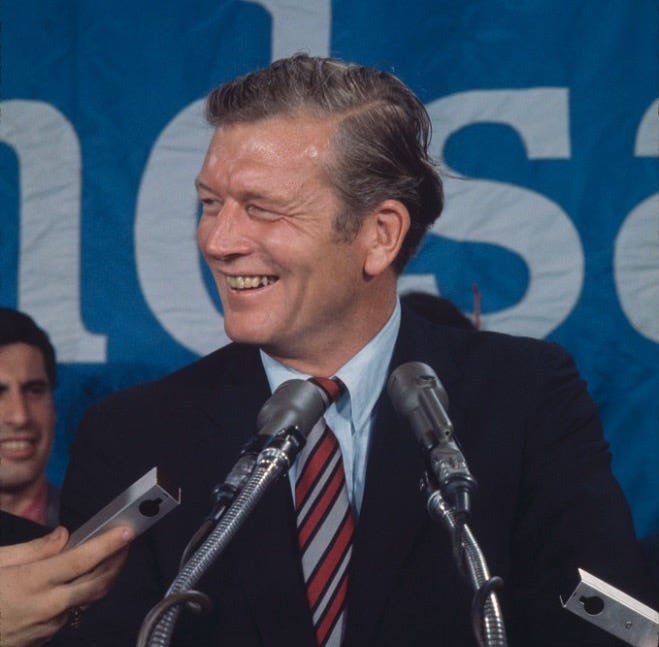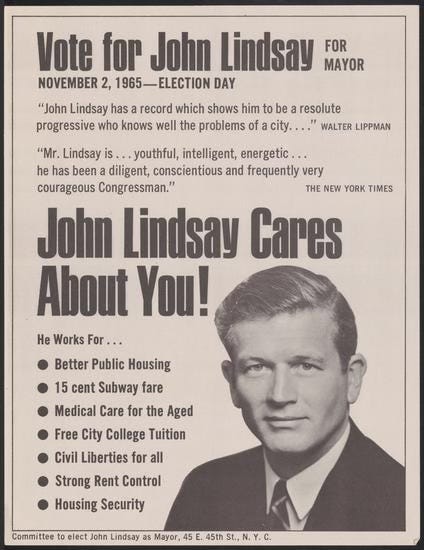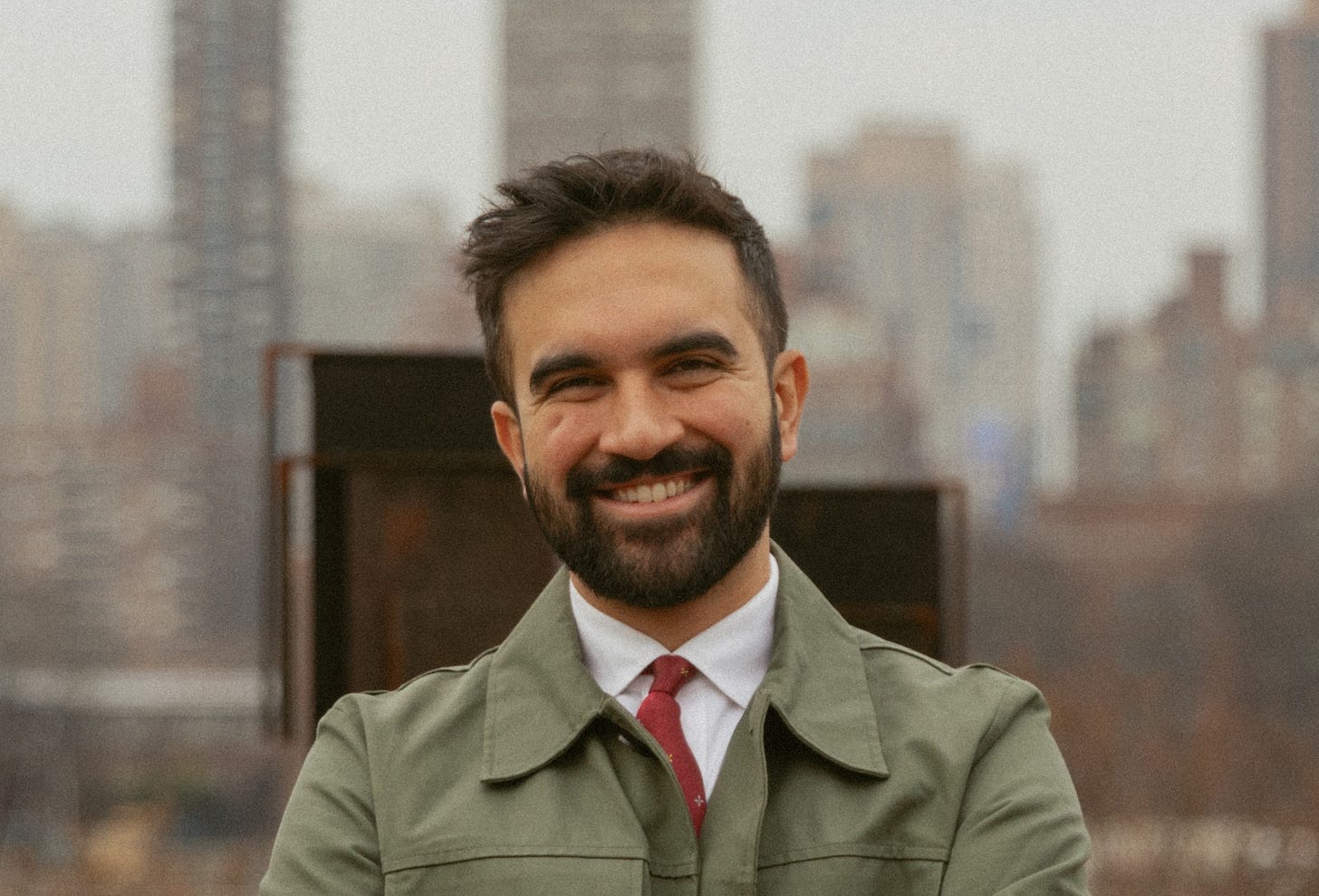Zohran Mamdani's great expectations
The big question about the politics of hope

On November 2, 1965, the 43-year-old Rep. John V. Lindsay eked out a victory in New York City’s mayoral election. After 12 years of Mayor Robert Wagner’s stolid stewardship, the telegenic liberal Republican promised to revitalize the city. The press was giddy.
“The politically incredible has come to pass,” The New York Times wrote in an editorial. “This city, weary of twenty long years of plodding one-party rule, has cast its vote for a better future. The people have made it plain that they want a change. They will get it in Lindsay.”
The six-foot-four-inch tall scion of a prosperous East Side family had Kennedyesque charisma and the liberal politics to match. Most of the city’s newspapers and many of its leading commentators endorsed him.
“The Times was so enamored of Lindsay in 1965 that Abe Rosenthal, by then the deputy managing editor, and Arthur Gelb, the metropolitan desk editor, upon hearing the news of Lindsay’s victory, reportedly hugged each other and yelled, ‘We’ve won!’, wrote Vincent Cannato in his book The Ungovernable City.
New Yorkers reacted similarly this year when another young and vibrant personality, Zohran Mamdani, won the Democratic primary and beat Andrew Cuomo and Curtis Sliwa in the general election.
With an unwavering focus on making New York more affordable, Mamdani wooed the millions struggling with the city’s high costs. He promises a rent freeze for tenants covered by rent stabilization, free bus rides and universal child care.
As a Democratic Socialist Party member and pro-Palestinian activist, he carries baggage that many New Yorkers find objectionable, including opposition to Israel’s status as a Jewish state and a failure to immediately condemn Hamas after its October 7 terrorist attack.
Critics questioned his advocacy of socialism, opposition to some of the school system’s gifted and talented programs and history of backing cuts in the NY Police Department’s budget. After the primary, he moderated his stances to appeal to a wider group of voters.
Mamdani celebrated a birthday October 18 with a cheeky video saying, “You’re worried about a 33-year-old becoming mayor of New York City, and I want you to know, I hear you. That’s why this weekend, I’ll be making a change. I’m turning 34. And I’m committing that for every single day from here on out, I will grow older.”
Enthusiasm

Mamdani stirred the kind of enthusiasm John Lindsay kindled, though the media has been a lot more equivocal. The New York Times declined to officially endorse a candidate in the Democratic primary. But the newspaper published an opinion article recommending against voting for Mamdani and backhandedly supporting Cuomo. It has since rolled out a spate of pieces trying to reflect on or jump aboard the pro-Mamdani bandwagon.
Writing for New York magazine, Frank Rich said Mandani “gives me rare hope at a time when I, like so many others, have soured on the Democratic old guard.” After meeting Mamdani, Rich wrote, “What I saw is what he projects in his campaign. A smart, focused guy who listens to others and welcomes tough questions; who is transparent and consistent on the core political convictions that guide him; who is not an ideologue or a glib Pez dispenser of consultantspeak; and, no less important, who knows what he doesn’t know.”
In a podcast with New Yorker editor David Reminick, Mamdani conceded that he has concerns about the high expectations voters have for him: “The weight of that hope is one that I do wrestle with. And the responsibility of living up to it.”
President Barack Obama, who campaigned as a candidate on the “audacity of hope,” called Mamdani to congratulate him the morning after the primary victory. Discussing that call with Remnick, Mamdani said it focused on “the importance of hope in our politics, and what the transition to governance looks like. There comes a responsibility with inspiring others, and with creating hope…you must deliver on that.”
That was precisely the test the Lindsay mayoralty failed: It never delivered on the hope inspired by the campaign.
Lindsay and ‘the innovation’ of hope
Lindsay’s campaign took as its slogan a line attributed to the brilliant newspaper columnist Murray Kempton: “He is fresh and everyone else is tired.”
That wasn’t exactly what Kempton wrote. He was a subtle and layered thinker who hedged his bets. So when he published his take on the mayoral race in a June 1965 article in The New Republic, he devoted much attention — and some praise — to the incumbent mayor, Robert F. Wagner, whom he assumed would run for a fourth term.
Wagner, he wrote, has the “goodwill of New Yorkers” and was seen as “essentially an honest man.”
The “imponderable” factors in the campaign, Kempton added, “are chiefly Lindsay’s youth and energy (he is 43, Wagner is 55) and the fact that he seems fresh when everyone else seems tired. ” (Note that he said Lindsay seems fresh, not is fresh.)
But even seeming fresh is “not altogether an asset,” added Kempton. The city’s “mood is exhausted” and people felt a bond with Wagner’s own exhaustion.
“Wagner’s mixture of resignation with enjoyment of his life is a very New York combination: the notion that New York cannot be governed has become almost a point of civic pride,” Kempton wrote. Still, Lindsay’s youthful confidence represented a threat to Wagner: “A politics founded on the habit of resignation will survive almost anything except the challenge of a politics founded on the innovation of hope.”
Five days after the New Republic published Kempton’s piece, Wagner dropped out of the race, citing his wife’s death and his desire to spend more time with his children. His replacement as the Democratic candidate turned out to be comptroller Abe Beame, a bland accountant who had worked his way up in New York’s machine politics. He was an uncharismatic figure, more than a foot shorter than Lindsay. Also in the race, though expecting to lose, was conservative author and commentator William F. Buckley Jr.
A Lindsay campaign poster was full of promises under the heading, “John Lindsay Cares About You!” Like Mamdani, he stressed making housing and transit affordable. Lindsay won with a plurality of the votes — 43% of the electorate — over Beame and Buckley.
‘Splendid flop’
Writing years later, it was again Murray Kempton who gave the considered verdict on the Lindsay years. In a 1991 piece for New York Newsday, Kempton called Lindsay a “shining failure,” under the headline: “A splendid flop.”
The mayor’s decline began on his first day in office, when the Transport Workers Union brought the subways and buses to a halt in a contract dispute. Lindsay gave the workers a 15 percent raise over two years and a pension sweetener that the Transit Authority had long opposed.
Whether or not Lindsay airily declared, “I won’t be here when those pensions have to be paid,” the bill would come due. The city nearly went bankrupt under the mayoralty of Abe Beame, who succeeded Lindsay in 1974.
As Kempton wrote of the transit worker settlement: “what a Mayor does unto one municipal labor union, he must do unto all others; and, having been denuded by the transit workers, Lindsay was naked before the aggressions of the rest of his work force.” Citing data from author Ken Auletta, Kempton wrote that city labor costs inceased 89.9% over the next five years of Lindsay’s government.
In fairness, Lindsay was partly the victim of negative trends that had been building for years under Mayor Wagner, but his actions failed to stem them. In addition to burgeoning municipal labor costs, the city had to cope with the collapse of its manufacturing sector, rising crime, overspending, tax increases, racial tension, “white flight” to the suburbs and bitter debates over schools and policing.
“The mayor has never been able to stop the city’s downward spiral,” wrote Steven R. Weisman in the Washington Monthly. “Services have continued to decline, division has deepened among races and economic classes, and there have been unending crises…new taxes were imposed one after another…but the quality of life in New York City has never seemed more bleak, its government never more sluggish, wasteful, and finally even helpless.”
Still, Lindsay drew praise for wading into the city’s streets at times when tensions were high, particularly after the assassination of Rev. Martin Luther King in 1968. “The Mayor had become a ceremonial officer memorable more for displays than for deeds,” wrote Kempton. “That figure taller than anyone around it in the steamy nights on Harlem streets remains unforgettable as the embodiment of a calming and magisterial civic dignity.”
“It scarcely matters that, without telling him, his more streetwise assistants had safeguarded these expeditions by paying off the more lively of the troublemakers who might otherwise disturb their serenity and that he was traveling rather as the Empress Catherine did through those villages her faithful servitor Potemkin had ordered put up and populated by happy serfs to gladden her imperial eye…”
Lindsay rightly took pride in the gifted young idealists he recruited to join city government, many of whom went on to lead city institutions in the following decades.
Despite his efforts, pro-Lindsay journalists turned on him with a vengeance. Nat Hentoff of the Village Voice wrote three years after his 1969 book in praise of the mayor that it “was the single biggest error of judgment I have made as a journalist.” Vincent Cannato quoted journalists Jack Newfield and Paul DuBrul, who observed in 1977 that “John Lindsay gave good intentions a bad name…He wanted to do good, but he didn’t know how.”
As Cannato noted, “much is expected of those who promise so much. And John Lindsay foundered on the shoals of his unfulfilled promises.”
Lindsay changed his party affiliation to the Democrats, mounted a 1972 primary campaign for the presidency that failed and decided not to seek a third term as mayor.
Reaching the voters
After the wreckage of the Beame years, another New York congressman, Edward I. Koch won the mayoralty. He realized that New Yorkers, and more particularly the tabloid press, wanted a big personality, a narrator-in-chief as mayor. For 12 years, he dominated the narrative, though serious cracks began to show with the scandals of his final term.
Rudy Giuliani and Mike Bloomberg also aspired to be that kind of a narrator for the city, with varying degrees of success.
In some ways, Mamdani will have it a little easier. The city’s media is fractured and arguably less influential than ever before. A mayor can bypass reporters and appeal directly to voters through social media. And Mamdani is particularly good at that.
Adam Gabbatt of the Guardian noted that “The first video of his campaign for mayor showed Mamdani walking around New York, talking about the cost of living over a slow-tempo hip-hop beat.
The candidate’s videos “look cool, but they’re relentlessly on message. In his debut, Mamdani identified how, in his words, New Yorkers were ‘being crushed by rent and childcare’ while ‘working people [are] being pushed out of the city they built’.”
Whitney Curry Wimbish of the American Prospect pointed to “a moment midway through the first New York City mayoral debate … that perfectly captured how drastically out of touch mainstream, establishment Democrats are with their constituents.” The debate’s moderator asked former Gov. Andrew Cuomo, who is running as an independent, what he had learned from his 12-point loss in the Democratic primary.
“I think in the primary campaign, I did not do enough on social media,” Cuomo responded. “That has changed now.”
That left an opening for Mamdani, who said, “It’s been an hour and 20 minutes of this debate and we haven’t heard Governor Cuomo say the word ‘affordability.’ That’s why he lost the primary. That’s why he’ll lose the general election.”
But it’s one thing to identify a salient issue like affordability. It’s another to make progress on it.
And now…
To pay for his programs, Mamdani will have to get new taxes from Albany under Gov. Kathy Hochul, who faces her own election challenge next year. He will have to make deals with a business community that is wary of his allegiance to socialist views and raises valid questions about his proposal to open city-owned grocery stores.
And he will have to fend off a barrage of criticism from President Donald Trump and his allies, who see Mamdani’s leftist views as a hammer they can use against Democrats nationally.
Yet Mamdani and Trump may learn to warily co-exist, with each of them finding the other useful as a villain who stirs up their respective party bases.
But advocating for New York with Washington and reaching out to the public, in Mamdani’s case with clever videos, are only small parts of the mayor’s job.
The mayors who have thrived in New York have been the ones who convinced the media and the voters that they were making things happen — not the ones like John Lindsay, who mostly became known for the things that happened to them.
Note: This post has been updated with the results of the Nov. 4 election.






Not being a New Yorker, I've watched the Mamdani phenomenon from afar, impressed by the hope he has awakened in a presumably cynical people. Not at all surprised to hear in the Remnick interview that Mamdani hails from cultural royalty (father a professor at Colombia, mother the filmmaker Mira Nair -- Monsoon Wedding is fantastic!), I understood where the poise and polish came from. The nimble mind and articulate nature too. Your Lindsay comparison is instructive. (I think about New York City in the 70s, which may be where our dear national leader gets his rigid "idee fixe" of our big Democrat cities as hellholes under siege--somewhat accurate then, much less so now. But that's a separate issue.) Our national experience with Obama is too.
Hope can be a dangerous thing. Especially the highly friable kind of hope that crumbles when it collides with intransigeant political reality and comes crashing to the ground. One is tempted to highlight once again the chasm between what it takes to campaign and what it takes to govern, the poetry and prose thing. I can't imagine that anything but a brutal awakening would await a newly elected Mayor Mamdani, especially with the full force of the federal government (in the hands on one Donald Trump) turned against him. Is knowing that this is coming sufficient incentive to turn a critical mass of NYC voters against him? Or course Cuomo, the corrupt relic of a fossilized system, isn't exactly an attractive alternative.
May the voters in New York City make the best possible choice, and may Mamdani, if elected, walk the tightrope skillfully--learning to deploy the dark arts of pragmatism without pissing too many people off. Not too many people could do it. Maybe he can.
Excellent piece!!